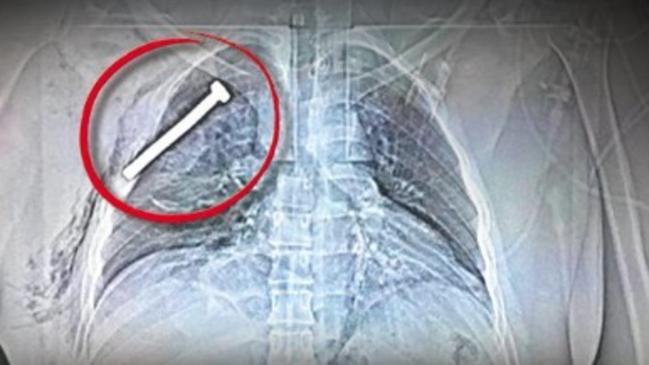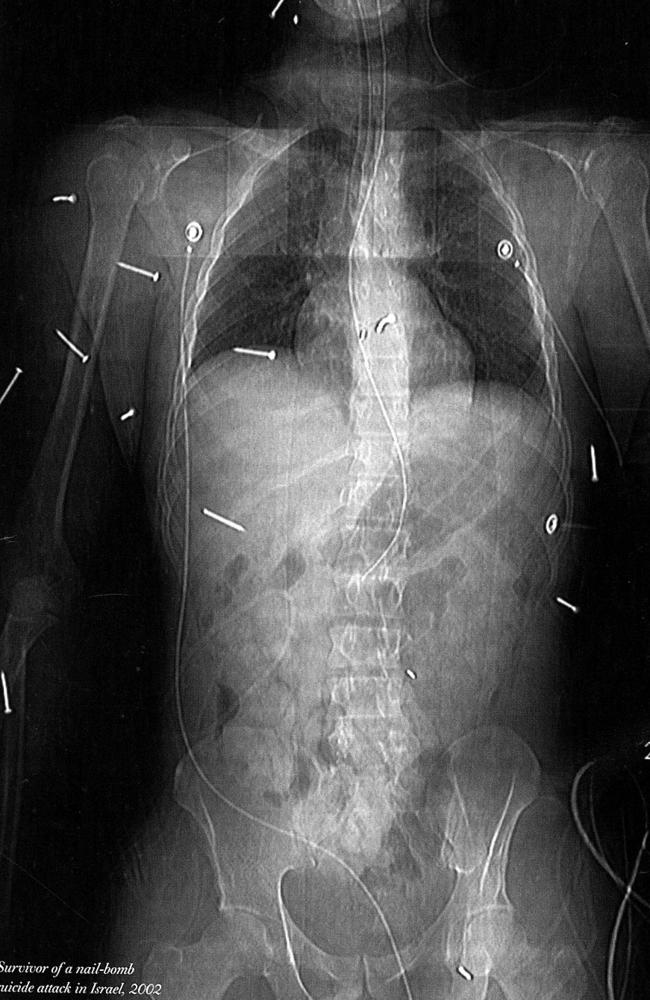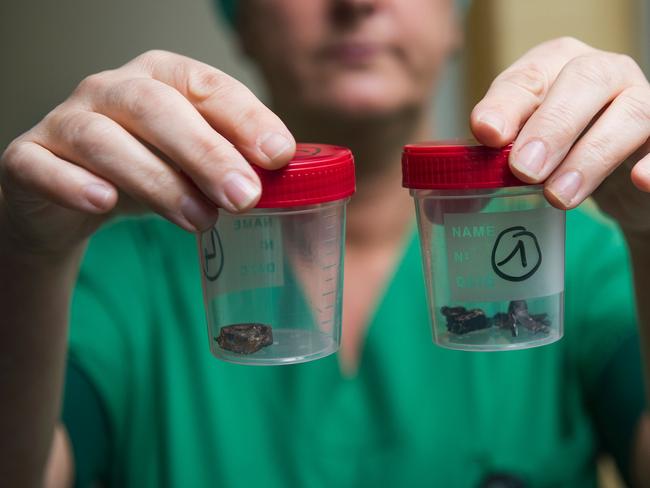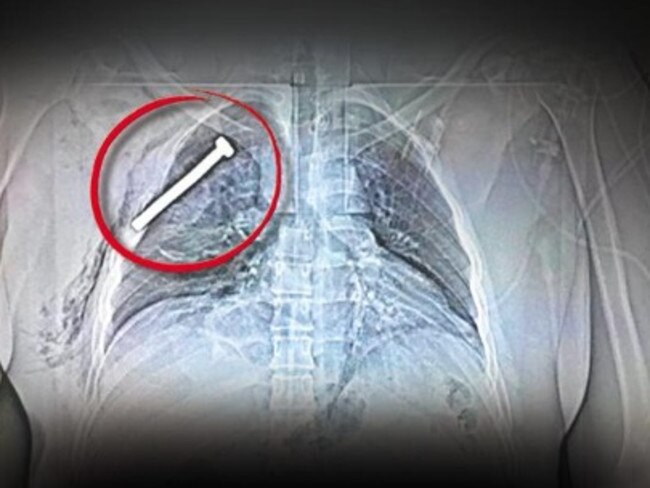The devastating impact of pressure cooker bombs in terror attacks
WITNESSES at the Manchester Arena say a bomb containing nails killed 22 people. This is why they’re popular with terrorists. WARNING: Graphic

WARNING: Graphic content
AUTHORITIES at the Manchester Arena believe an improvised explosive device is responsible for much of the carnage, including 22 deaths, at an Ariana Grande concert.
Witnesses have reported seeing shrapnel around the scene that suggest the bomb may have contained nails, screws and nuts.
So gruesome was the aftermath, body parts were reportedly scattered through the carnage.
TMZ reports “the explosive device was a nail bomb in a backpack and it might have been a suicide mission”.
The publication said it appeared “the bomber was waiting around the exit area as people were streaming out of the building”.


So popular are these types of bombs they have been used in a variety of attacks across the world, including the Boston Marathon bombings, St Petersburg, Brussels, West Java, and New York City terror attacks along with attempts in Germany.
Additionally, an Islamic State terrorist taught a Melbourne teenager how to make a pressure cooker bomb and urged him to plot an attack on the city in 2015.
Reports out of the U.K claim a nail bomb explosion caused the fatalities at the Ariana Grande concert in Manchester. Still unconfirmed.
— Perez (@ThePerezHilton) May 22, 2017
The moment the explosion happened at the Ariana Grande gig tonight in #Manchester pic.twitter.com/amxnTyearP
— Alan Spence (@AlanSpenceEDL) May 23, 2017
Imagine being a child, at your first concert, and experiencing that hell.
— Daniel Andrews (@DanielAndrewsMP) May 23, 2017
Counter IED Expert Jeff Parks told CNN the explosive devices first came onto the scene in the early-2000s in Iraq, claiming it was a “very common appliance in the Middle East” and “very handy to place a large amount of explosives and shrapnel”.
“It was definitely a bomb, the whole building shook. Body parts were everywhere, a torso, an ear. It was the worst thing I have ever seen. Bodies were everywhere,” a woman in Manchester, identified only as Emma, told BBC Radio.
Gary Walker, from the nearby city of Leeds, told the BBC he was injured by shrapnel as the explosion went off a few metres away while he and his wife waited for their daughters to emerge from the concert.
“We heard the last song go and then suddenly there was a massive flash and then a bang and smoke. I felt a pain in my foot and my leg,” Walker said. “I turned around to my wife, who was standing at the side of me, and she said, ‘I need to lay down.’ She’s got a stomach wound and possible a broken leg,” he said.
“I’ve got a bit of a hole in my foot where I’ve got a bit of shrapnel. I was surprised I got away so lightly.”
Walker said he saw metal nuts that he believed could have come from an explosive device.
One victim’s injuries in the immediate aftermath of the Ariana Grande concert were posted to Twitter with what appears to be blood dripping from their legs.
Others said they were “covered in people’s blood, skin”.
#Manchester Fan with injured legs at Ariana Grande gig explosion tonight pic.twitter.com/QLQOla4wix
— Alan Spence (@AlanSpenceEDL) May 22, 2017

Such devices were used in the Boston bombing attacks and the terror attacks in Brussels.
In Boston, the bombers hid the bombs inside a nylon backpack while the device was triggered by a battery operated timer. The evidence suggested ball bearings and nails were placed around the explosive, sending small projectiles towards spectators, causing injuries to the lower body.
The force of the blast was so powerful, it sent the lid of the pressure cooker onto the roof of an adjacent building.
“These bombs contained small metallic fragments more consistent with pellets and other small pieces of metal, but also spiked points that resembled nails without heads,” George Velmahos, head of emergency medicine at Massachusetts General Hospital, said at the time.
The two bombs, which exploded 13 seconds and about 100 metres apart, sprayed the shrapnel into the crowd of thousands of people lining Boylston Street to watch the runners of the famous race cross the finish line.
Three people were killed and at least 180 injured. The dead and injured were aged between two and 71 and included nine children.
In New York, Ahmad Rahami, a naturalised United States citizen of Afghan birth, was identified with the help of a mobile phone left behind with an unexploded pressure cooker found near the site of a bomb blast.
He is believed to be the same man seen in black and white surveillance video taken at the site the bombing in September last year in the Chelsea neighbourhood of Manhattan which injured 29 people.
Police also believe Rahami was behind a pipe bomb that exploded in a trash can on the route of a Marine Corps run in New Jersey.
In December last year, a 12-year-old boy allegedly tried to detonate a homemade nail bomb at a Christmas market in Germany.
The homemade device — a glass jar filled with a combustible powder and nails — was discovered on December 5 in the western city of Ludwigshafen and destroyed by police.
In Brussels, at least one of the bombs, detonated at Zaventem airport in March last year, was packed with nails.
A horrifying x-ray image was released showing a victim of the Brussels terror attacks with a giant nail or screw lodged in their chest.


At least 34 people were killed and around 250 injured in the three separate bomb blasts at the city’s airport and Maelbeek metro station.
Injuries included fractures and deep cuts caused by flying glass and nails.
In today’s news, Manchester Police say the scene is currently being treated as a terrorist incident until police know otherwise. At least 22 people have been confirmed dead while 50 others are among the injured.
Chief Constable Hopkins said Manchester police were working closely with the national counter-terrorism policing network and UK intelligence partners.
“This is clearly a very concerning time for everyone,” he said.
“We’re doing all that we can, working with local and national agencies to support those affected, as we gather information about what happened last night.”
It’s feared many of the victims of the explosion were young girls, who had attended the popular pop star’s concert.
The moment the explosion happened at the Ariana Grande gig tonight in #Manchester pic.twitter.com/amxnTyearP
— Alan Spence (@AlanSpenceEDL) May 23, 2017



